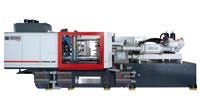Ferromatik in fast lane with Vitesse
Malterdingen, Germany—Many have tried, few have had much success, but Ferromatik Milacron officials speaking on May 12 during the firm’s open house predict their new machine range, dubbed Vitesse (French for “speed”), could help the company put even more pressure on the most established manufacturers of high-speed molding machines for thin-walled packaging, namely Husky and Netstal.
May 13, 2009
Malterdingen, Germany—Many have tried, few have had much success, but Ferromatik Milacron officials speaking on May 12 during the firm’s open house predict their new machine range, dubbed Vitesse (French for “speed”), could help the company put even more pressure on the most established manufacturers of high-speed molding machines for thin-walled packaging, namely Husky and Netstal. About 20 of the Vitesse hydraulic machines have been in testing at selected customers since 2007, said Guy Moillet, the company’s managing director, with feedback from these already coordinated into the range so that it is now ready for broader marketing.
|
“We did not have to change much from these prototypes” to realize the commercial models, Moillet said. The new range is in essence an improved and more versatile version of the Cap-Tec machines for closure molding which the firm introduced two years ago (read story here) during its open house. The Vitesse range will envelop the Cap-Tec closure molding machines, but with the new machines offering molders more space between platens for larger molds and thus greater flexibility with regard to applications. The packaging industry, which usually accounted for about one-third of the company’s sales, has risen in importance and now accounts for about half of sales, said Moillet, as demand from processors in consumer goods, E/E, and other markets slows.
Thorsten Thürman, manager process engineering and systems, said the Vitesse range includes a number of molder-friendly aspects. For instance, the base of the machines is built on a sandwich design so that water lines for mold cooling can be fed through the base and up to the mold, freeing space around the topside of the machine. The screw length has been extended to 25 L/D to enable the machine to plasticize more material and thus feed larger molds. To now, the largest model offered in the range is a 400-tonne machine, but a 500-tonne press will be offered by year’s end, said Marc Tesche, applications engineering director.
Among interesting applications running during the open house on the new machines was an inmold-labeled lid being processed on the Vitesse 400 (400-tonne) machine, with the labels converted by Italian label supplier Viappiani featuring pictures of strawberries that also smell like the fruit. Japan’s Star Seiki, via its European subsidiary, supplied the automation for the IML unit. Lids weighed 24.8 g and were molded in 4.4 seconds/cycle.
Most vividly demonstrating the speed possible with the Vitesse range was a 200-tonne machine molding polypropylene egg cartons, each holding six eggs and weighing 21.8 g. Wall thickness of these was just 0.4 mm, and cycle times hovered between 1.8-1.9 seconds. As on other applications running, the material, in this case grade FPH50 Flowpact, was supplied by Sabic. A hot runner system from D-M-E, mold from AVM, and material feeding system from Colortronic completed the package. —[email protected]
About the Author(s)
You May Also Like



